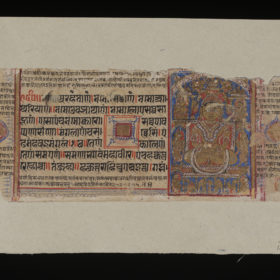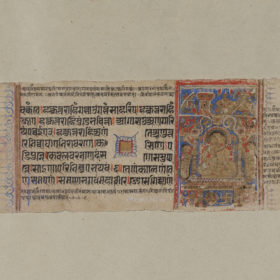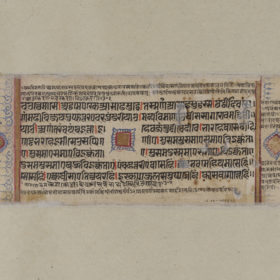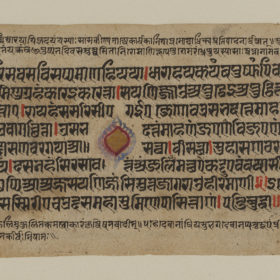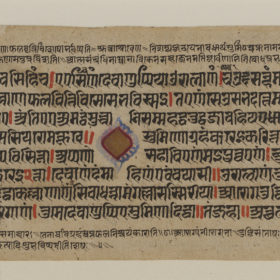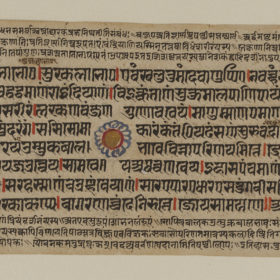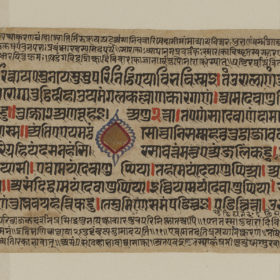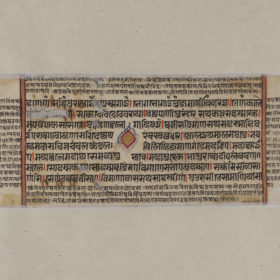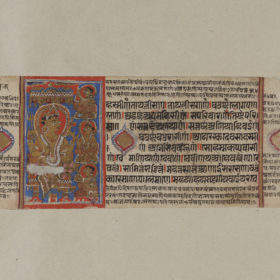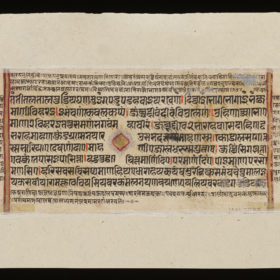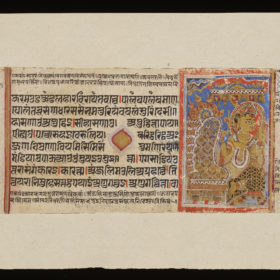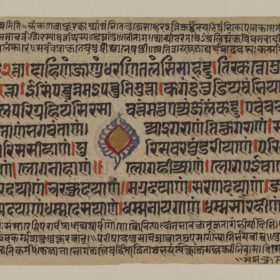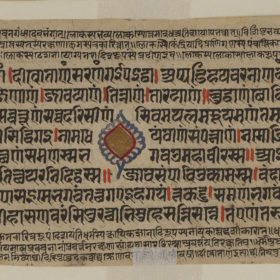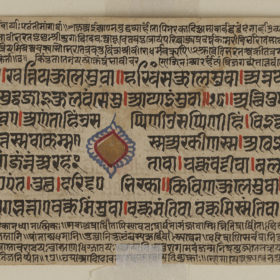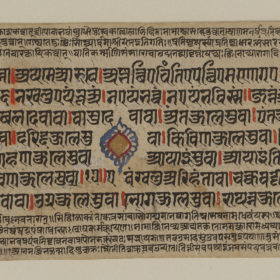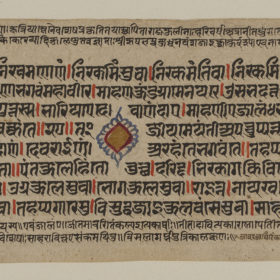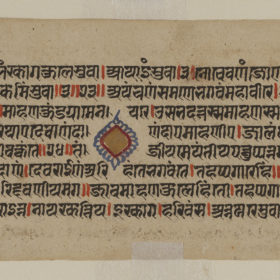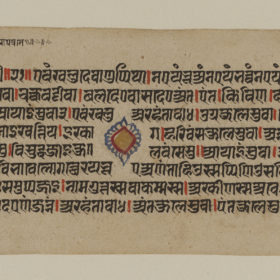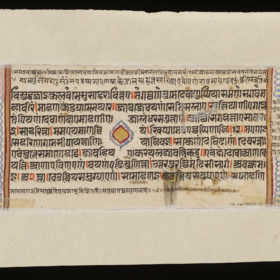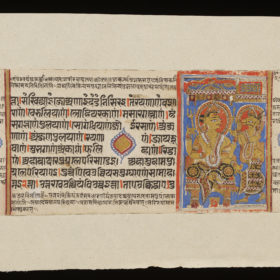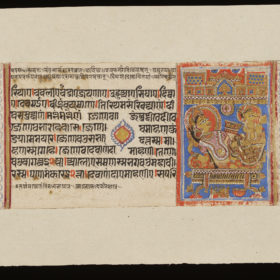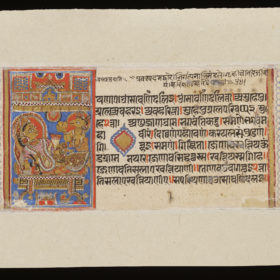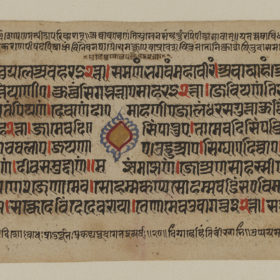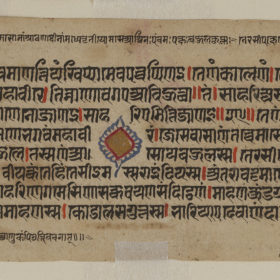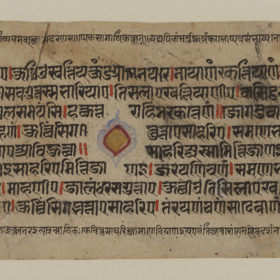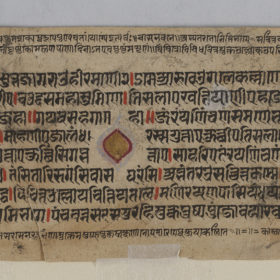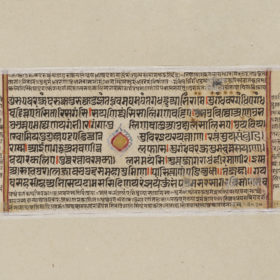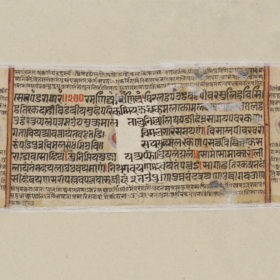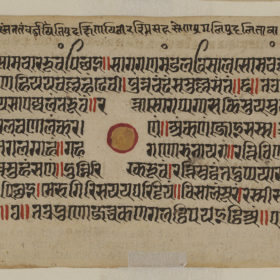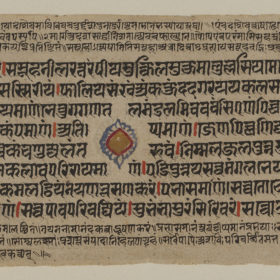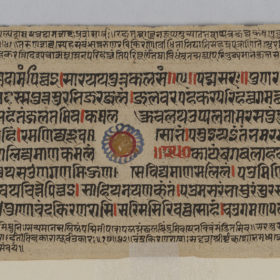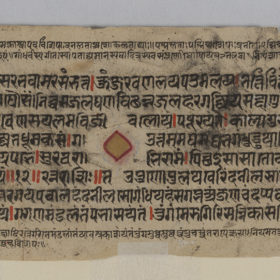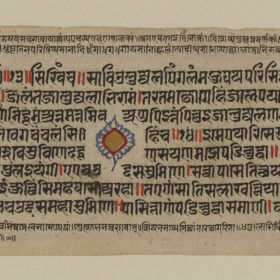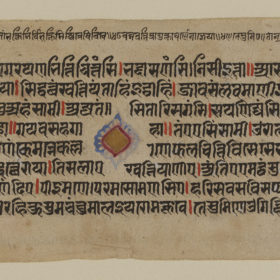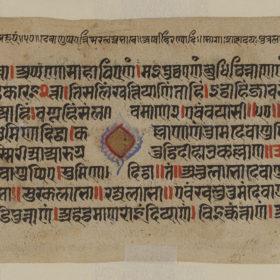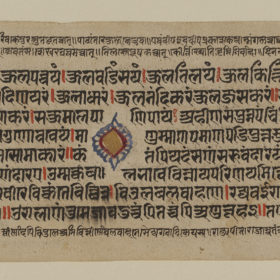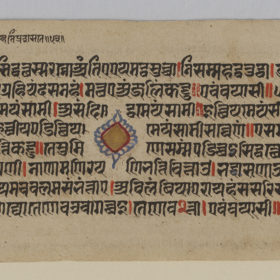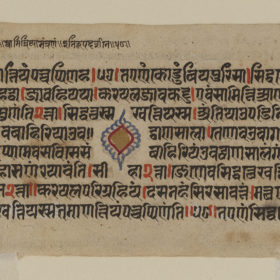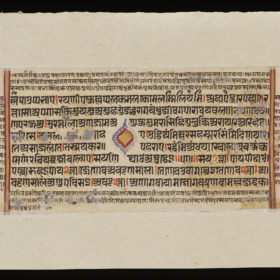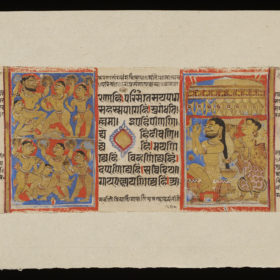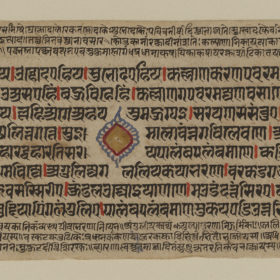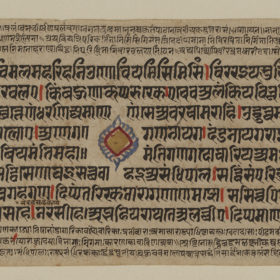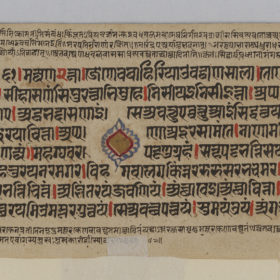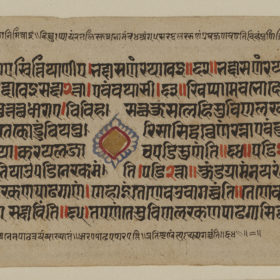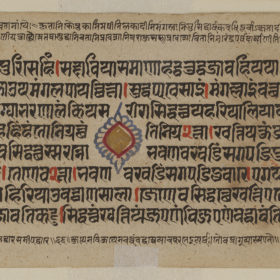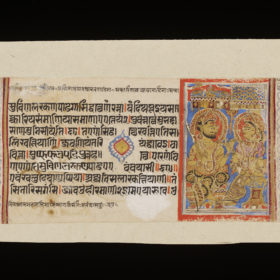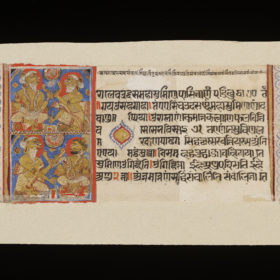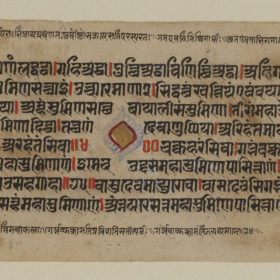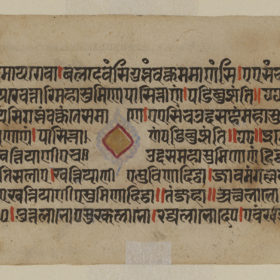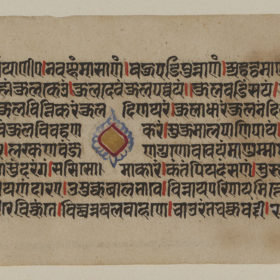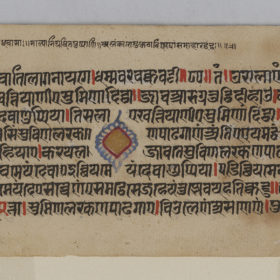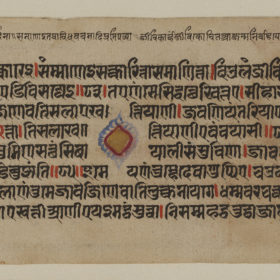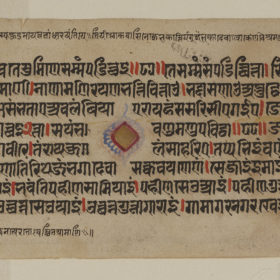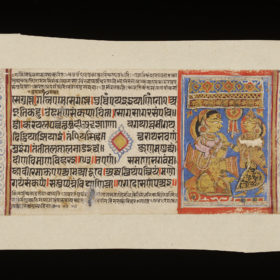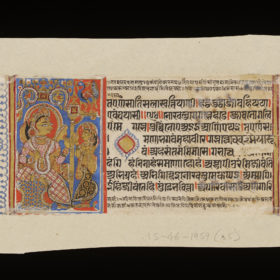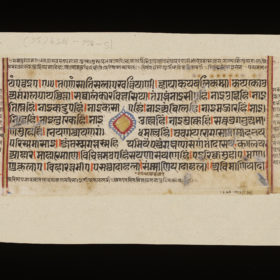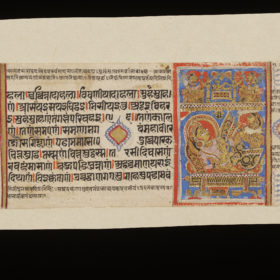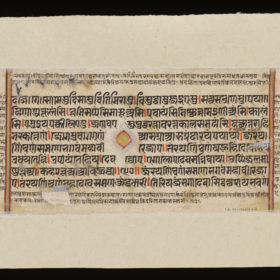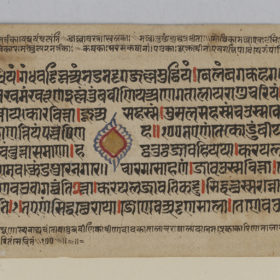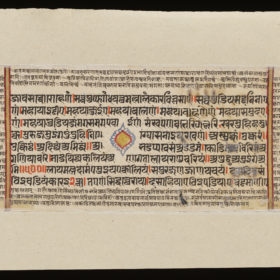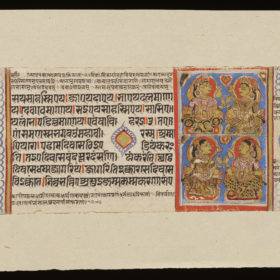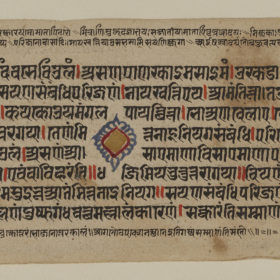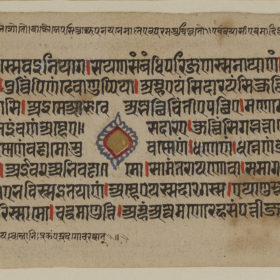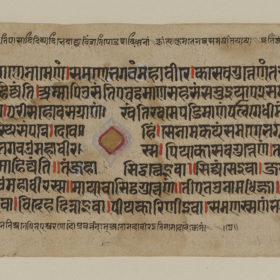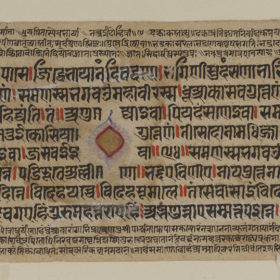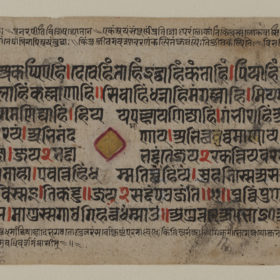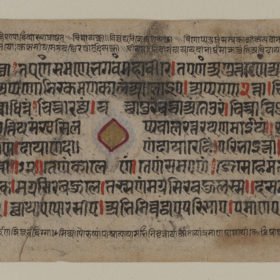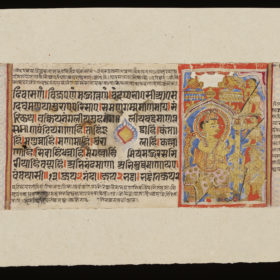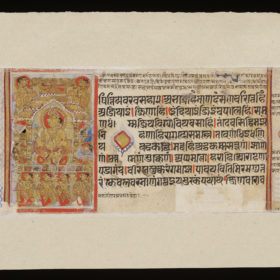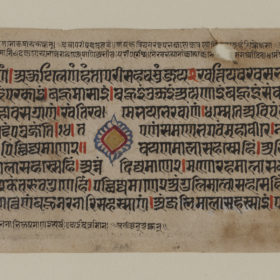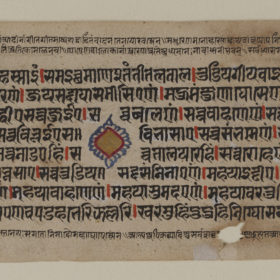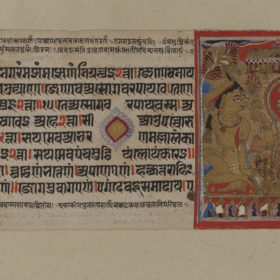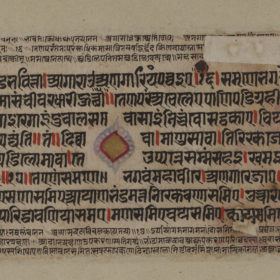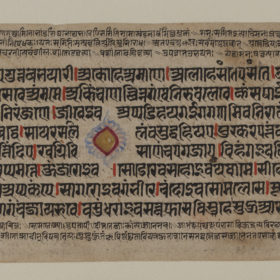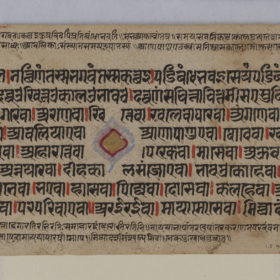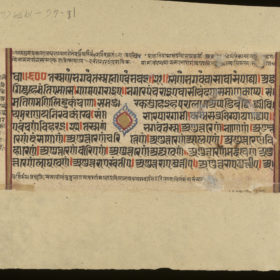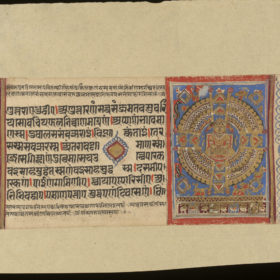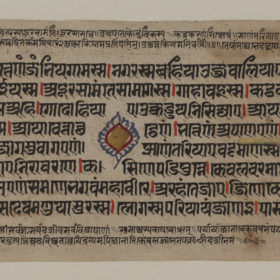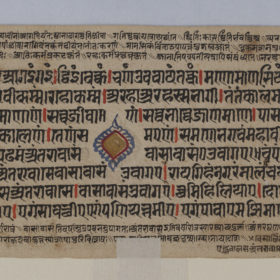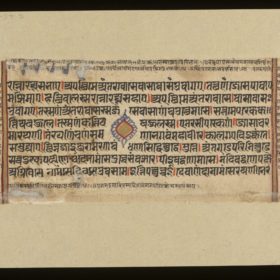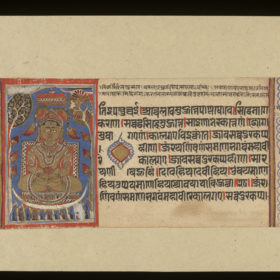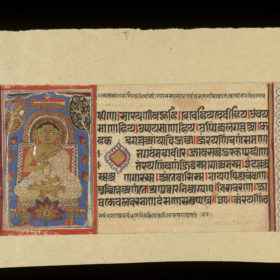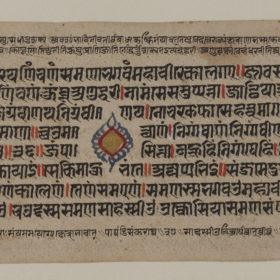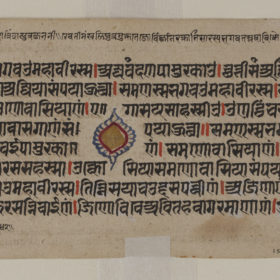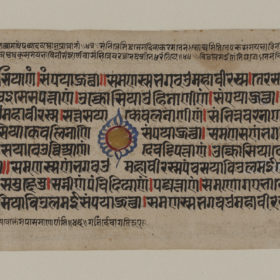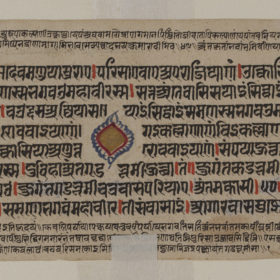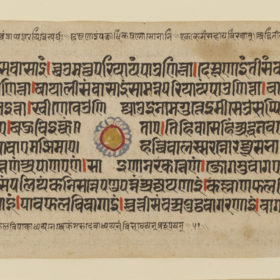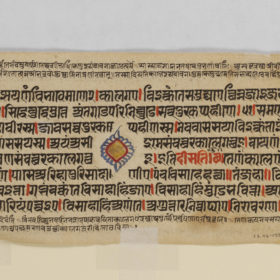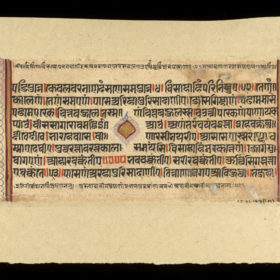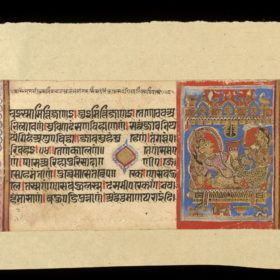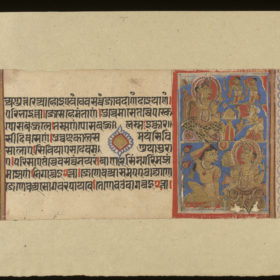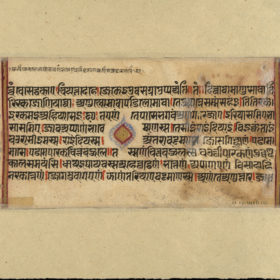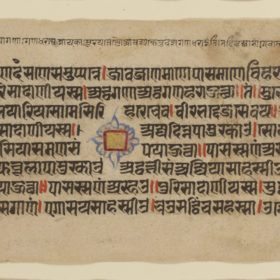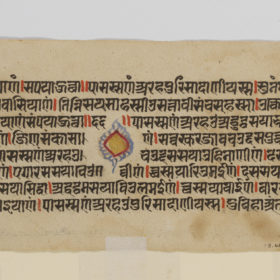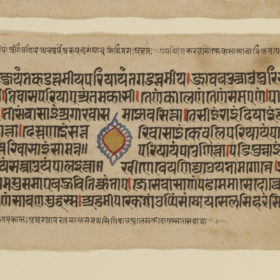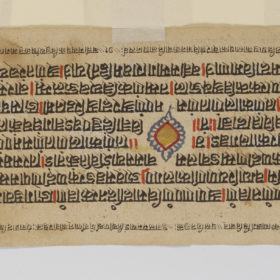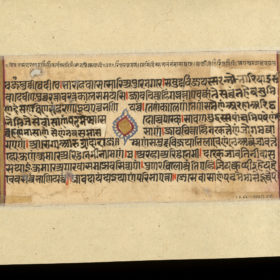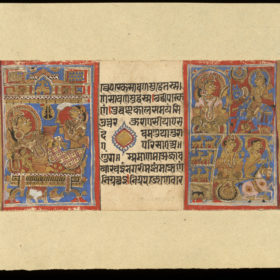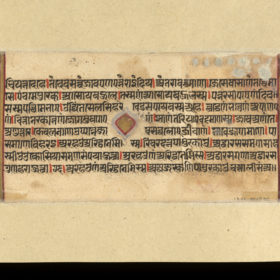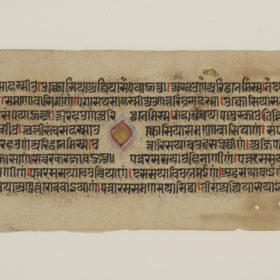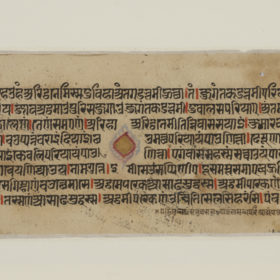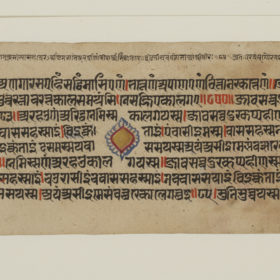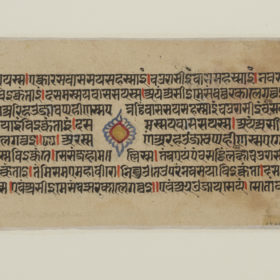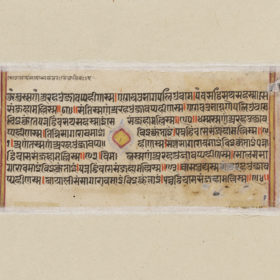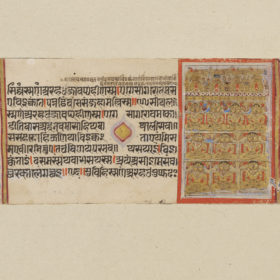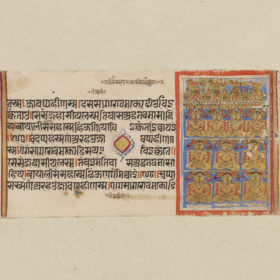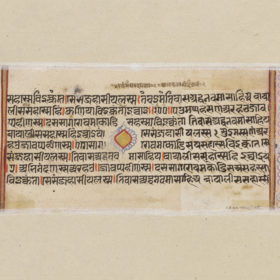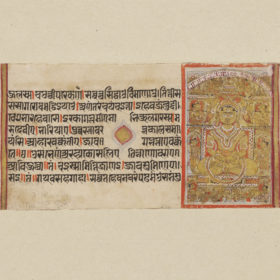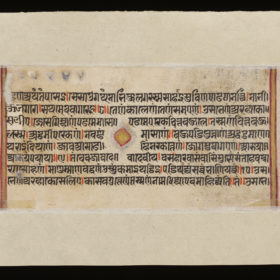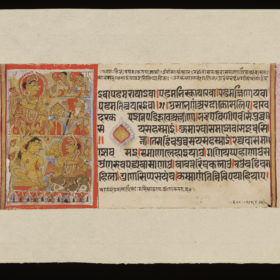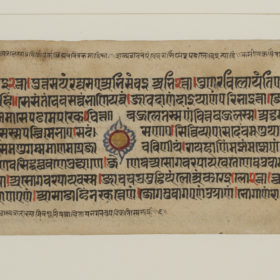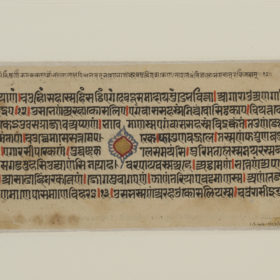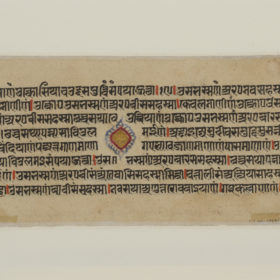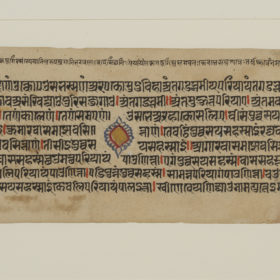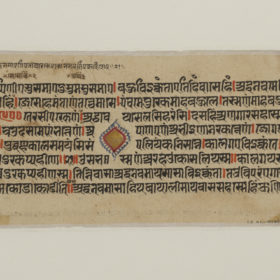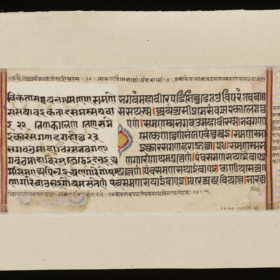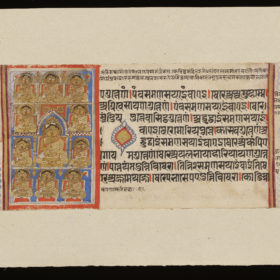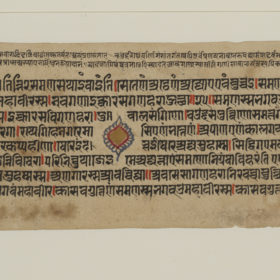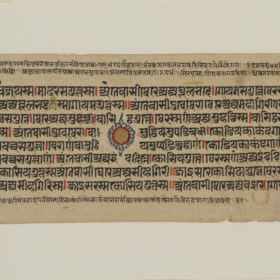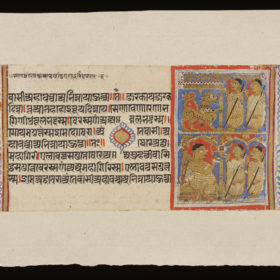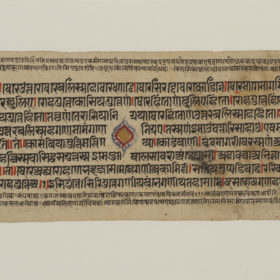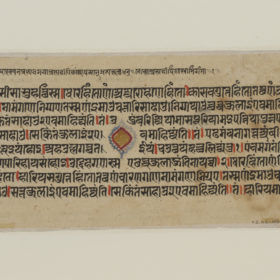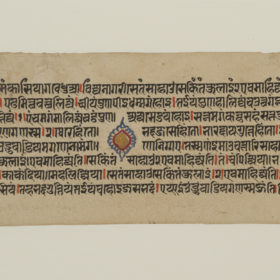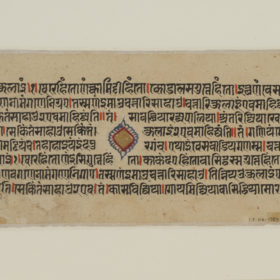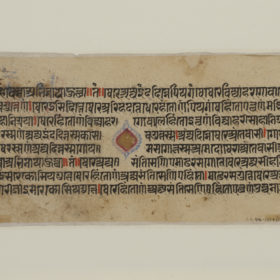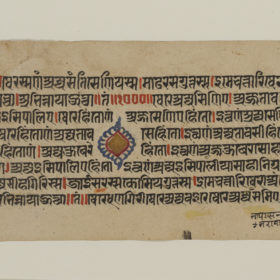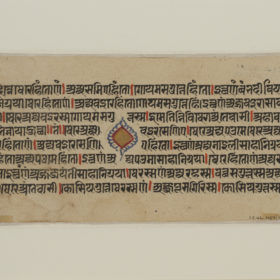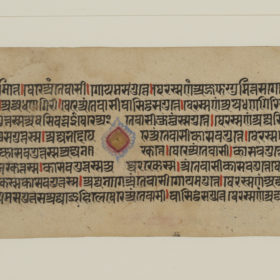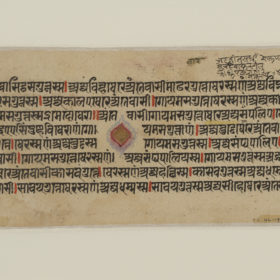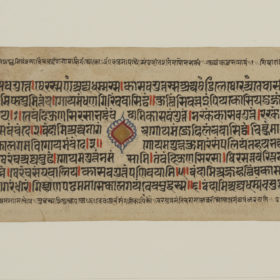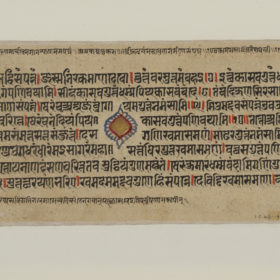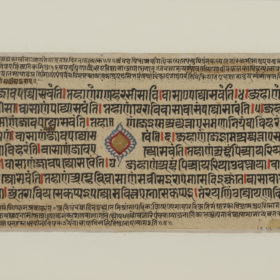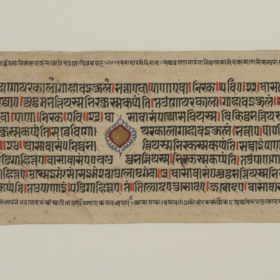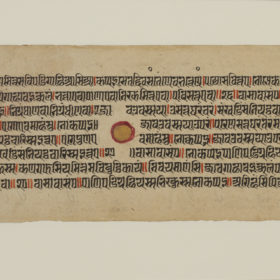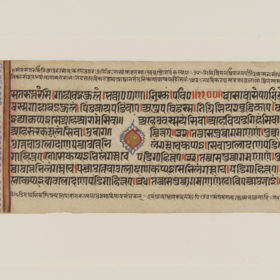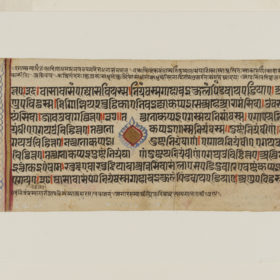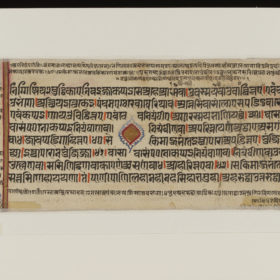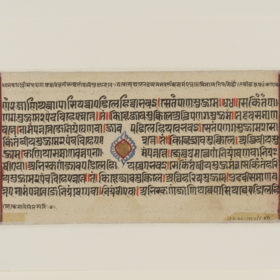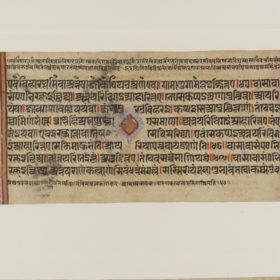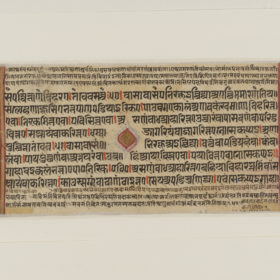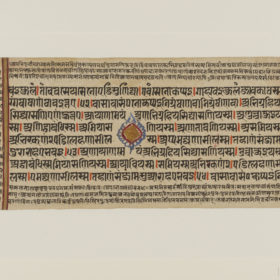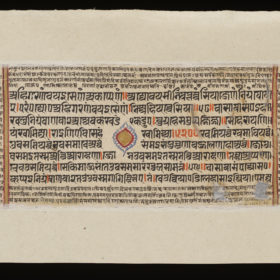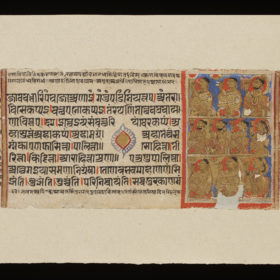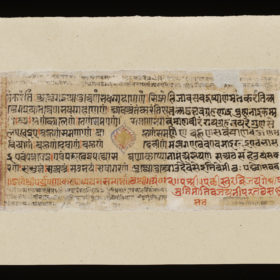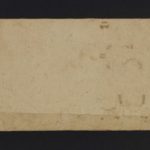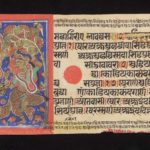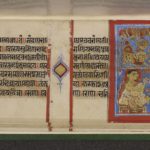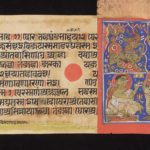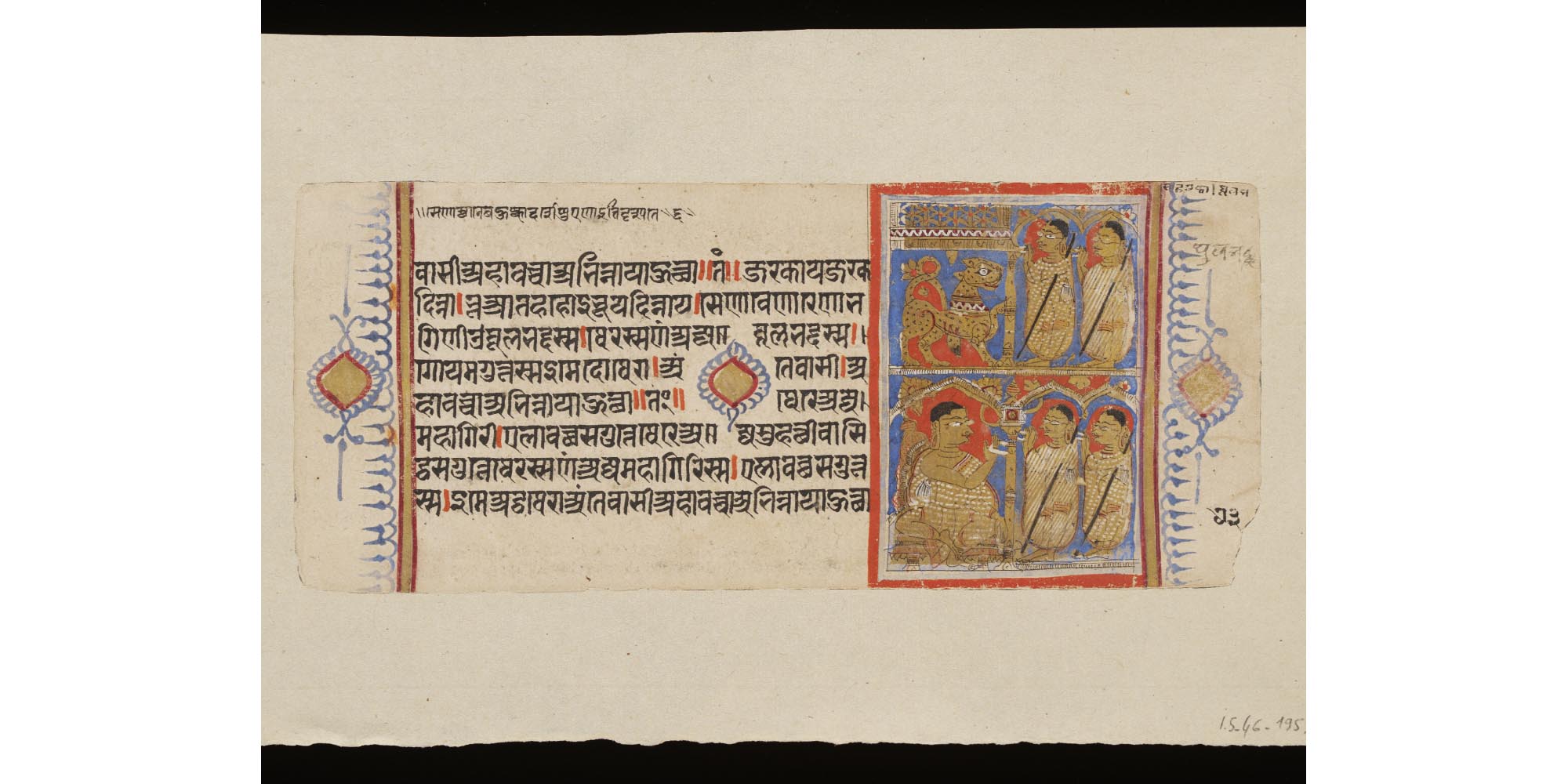
Background
Glossary
Description
Top level
A jumping lion is shown, facing two Śvetāmbara nuns. They are easily recognised through their characteristic monastic robes and their monastic equipment. Both carry the monastic staff – daṇḍa. They hold monastic brooms – rajoharaṇas – under their arms, though the second one is very faded. Both hold their mouth-cloths in their hands, which signals that they are in conversation.Bottom level
A Śvetāmbara monk sits on a slightly raised seat. He wears the typical monastic robe, carries the monastic broom under his arm and holds the mouth-cloth in front of him, which shows that he is talking. Facing him are two Jain nuns, who are identical to those depicted in the first scene. Nuns are distinguished from monks in art by the feminine features of their faces and by the fact that their monastic robe goes up to their necks. They are not allowed to have an uncovered shoulder as the seated monk has here. This illustration shows episodes featuring two famous elders or early Jain teachers, Bhadrabāhu and Sthūlabhadra, as well as the latter’s sisters. The top scene shows Sthūlabhadra and his sisters. After Sthūlabhadra has become a monk, his seven sisters also decide to renounce the world. They decide to pay their respects to their brother. When they reach the area, Sthūlabhadra thinks he will show them a miracle and changes himself into a lion. The seven sisters are generally represented by only two figures in Jain art. The lower scene shows what happens next. Turning away in fear, the sisters go to the teacher Bhadrabāhu, who had told them where Sthūlabhadra was to be found. They say that a lion has probably eaten their brother. Bhadrabāhu explains the truth to the nuns. The long protruding eye is a typical feature of western Indian painting. Its origin is unclear.Other visual elements
The bottom of the right margin contains the number 73. This is the folio number. The original paper has been pasted onto a new base. As with many Kalpa-sūtra manuscripts, there is a clear intention to make the manuscript a valuable and remarkable object in itself. This aim is signalled by the:- use of gold in the paintings, margins and ornamental motifs
- decorated border with blue floral motifs
- three diamonds filled with gold ink and surrounded by blue ornamental motifs.
Script
The elaborate script used is the Jaina Devanāgarī script, which is here like calligraphy. It is used for writing numerous Indian languages, here for Ardhamāgadhī Prakrit. There are a few notable features of this script, which:- is an old type in the way the sounds e and o are notated when used with a consonant, known as pṛṣṭhamātrā script
- contains red vertical lines that mark out verse divisions, with a single line dividing a verse in two while double lines are found at the end of the verse.
- Source:
Victoria and Albert Museum
- Shelfmark:
IS 46-1959
- Author:
unknown
- Date of creation:
late 15th to 16th centuries
- Folio number:
73 verso
- Total number of folios:
91 folios, numbered 1-92, with folio 3 missing
- Place of creation:
Gujarat
- Language:
Prākrit with Sanskrit commentary
- Medium:
watercolour on paper
- Size:
26 x 10.5 cm
- Copyright:
V&A Images/Victoria and Albert Museum, London
- Image Copyright:
Description
The caption in the top-right corner reads: sīha guphā Thūlabhadda – ‘the lion’s cavern, Sthūlabhadra’.
The illustration has two scenes on different levels, each illustrating a different episode in the life of Sthūlabhadra, an early Jain teacher.
Top level
A jumping lion is shown, facing two Śvetāmbara nuns. They are easily recognised through their characteristic monastic robes and their monastic equipment. Both carry the monastic staff – daṇḍa. They hold monastic brooms – rajoharaṇas – under their arms, though the second one is very faded. Both hold their mouth-cloths in their hands, which signals that they are in conversation.
Bottom level
A Śvetāmbara monk sits on a slightly raised seat. He wears the typical monastic robe, carries the monastic broom under his arm and holds the mouth-cloth in front of him, which shows that he is talking. Facing him are two Jain nuns, who are identical to those depicted in the first scene.
Nuns are distinguished from monks in art by the feminine features of their faces and by the fact that their monastic robe goes up to their necks. They are not allowed to have an uncovered shoulder as the seated monk has here.
This illustration shows episodes featuring two famous elders or early Jain teachers, Bhadrabāhu and Sthūlabhadra, as well as the latter’s sisters.
The top scene shows Sthūlabhadra and his sisters. After Sthūlabhadra has become a monk, his seven sisters also decide to renounce the world. They decide to pay their respects to their brother. When they reach the area, Sthūlabhadra thinks he will show them a miracle and changes himself into a lion. The seven sisters are generally represented by only two figures in Jain art.
The lower scene shows what happens next. Turning away in fear, the sisters go to the teacher Bhadrabāhu, who had told them where Sthūlabhadra was to be found. They say that a lion has probably eaten their brother. Bhadrabāhu explains the truth to the nuns.
The long protruding eye is a typical feature of western Indian painting. Its origin is unclear.
Other visual elements
The bottom of the right margin contains the number 73. This is the folio number.
The original paper has been pasted onto a new base. As with many Kalpa-sūtra manuscripts, there is a clear intention to make the manuscript a valuable and remarkable object in itself. This aim is signalled by the:
- use of gold in the paintings, margins and ornamental motifs
- decorated border with blue floral motifs
- three diamonds filled with gold ink and surrounded by blue ornamental motifs.
The three golden diamonds along the central horizontal plane are symbolic reminders of the way in which manuscripts were bound at one time. Strings through one or more holes in the paper were used to thread together the loose folios so the reader could turn them over easily. The shapes are in the places where the holes would once have been.
Three diamonds mean a verso side.
Script
The elaborate script used is the Jaina Devanāgarī script, which is here like calligraphy. It is used for writing numerous Indian languages, here for Ardhamāgadhī Prakrit.
There are a few notable features of this script, which:
- is an old type in the way the sounds e and o are notated when used with a consonant, known as pṛṣṭhamātrā script
- contains red vertical lines that mark out verse divisions, with a single line dividing a verse in two while double lines are found at the end of the verse.
The lines in smaller script above the main text are explanations in Sanskrit of phrases found in the central part, in line 6.





























































































